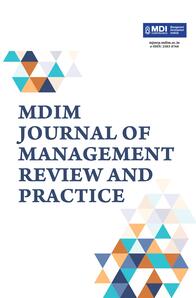
1 Department of Economics, Aligarh Muslim University, Aligarh, Uttar Pradesh, India
Creative Commons Non Commercial CC BY-NC: This article is distributed under the terms of the Creative Commons Attribution-NonCommercial 4.0 License (http://www.creativecommons.org/licenses/by-nc/4.0/) which permits non-Commercial use, reproduction and distribution of the work without further permission provided the original work is attributed.
The study’s primary goal is to determine how the increase in digital transactions has affected narrow money, also known as M1, which serves as a proxy for nominal GDP and national income. The National Electronic Funds Transfer (NEFT), the Immediate Payment System (IMPS), the Unified Payment Interface (UPI) and Mobile Banking (MB) are all used in the study as proxies for digital payment systems. In contrast, M1, or narrow money, is used as a proxy for the money supply in India from July 2016 to August 2022. Every month, the Reserve Bank of India database has served as the source of the statistics. The effect of digital transactions on M1 has been studied using the sophisticated econometric approach known as the ARDL (autoregressive distributed lag model). The presence of cointegration between the variables is further demonstrated by the long-run cointegration bound test. The findings of the diagnostic tests show that serial correlation and heteroskedasticity are absent. According to the results of the CUSUMSQ (CUSUM-square) and Jarque–Bera tests, the model is stable and normally distributed. Digital payments are statistically significant and positively correlated with the money supply, according to the error correction model test. The long-run equation results also demonstrate that the digital payments system might have a long-term positive or negative correlation with M1. Since every other independent variable, excluding IMPS, is positively connected to the money supply and IMPS is negatively related, the two are inversely related. The money supply will shrink as IMPS transaction volume rises, but this will have minimal substitution impact on the M1 monetary aggregate. Thus, the study’s findings imply that there might be several changes to the money supply or monetary aggregates, which are crucial tools of monetary policy, due to the impudent rise of financial innovations or additional fintech opportunities. Because of this, the demand for money function may become unstable, making it difficult for policymakers to put their plans into action.
Fintech, narrow money, ARDL model, error correction model and cointegration, monetary policy, IMPS, UPI, NEFT
Aminy, A. R. (2022). Analysis of influence of card-based payment and electronic money on money supply. Journal of Contemporary Information Technology, Management, and Accounting, 3(1), 48–56.
Chaudhari, D. R., Dhal, S., & Adki, S. M. (2019). Payment systems innovation and currency demand in India: Some applied perspectives. India Occasional Papers, 40(2), 33–63.
Columba, F. (2009). Narrow money and transaction technology: New disaggregated evidence. Journal of Economics and Business, 61(4), 312–325. https://doi.org/10.1016/j.jeconbus.2009.01.001
Hasanah, R., & Hasmarini, M. I. (2023). Analysis effect of cashless payments in the digitalization era on money supply in Indonesian (Vol. 1). Proceeding Medan International Conference Economics and Business. https://proceeding.umsu.ac.id/index.php/Miceb/article/view/216
Hye, Q. M. A. (2009). Financial innovation and demand for money in Pakistan. The Asian Economic Review, 51(2), 219–228.
Jain, R. (2023). Impact of cashless transactions on money supply—Case of India. https://doi.org/10.13140/RG.2.2.22551.55209
Kim Lien, N.T., Doan, T. R.T., & Bui, T.N. (2020). Fintech and banking: Evidence from Vietnam. Journal of Asian Finance, Economics and Business, 7(9), 419–426. https://doi.org/10.13106/JAFEB.2020.VOL7.NO9.419
Mulyani, Y., & Davronov, I. O. (2023). The effect of e-money on the money supply and inflation di Indonesia year 2019-2021. Sinergi International Journal of Management and Business, 1(1), 83–101.
Nakamya, M. (2014). The effect of financial innovation on money demand in Uganda: An examination of new payment technologies on demand for narrow money (HD06/1387U). https://publication.aercafricalibrary.org/server/api/core/bitstreams/6805c7a4-b845-4bdb-894d-6a3eb04f57c6/content
Pesaran, M. H., Shin, Y., & Smith, R. J. (2001). Bounds testing approaches to the analysis of level relationships. Journal of Applied Econometrics, 16(3), 289–326. https://doi.org/10.1002/jae.616
Research SBI & ECOWRAP. (2022). The power of digital transactions: Currency In circulation declines in a busy Diwali week for the first time in 20 years (in 2009, a marginal decline of Rs 9.5 bn but reflecting the crisis!) (Issue No. 42). 1–7.
Song, J., Shuang, Q., & Hong, Z. (2022). Will digital financial development affect the effectiveness of monetary policy in emerging market countries? Economic Research Ekonomska Istraživanja, 35(1), 3437–3472. doi: 10.1080/1331677X.2021.1997619
Tee, H.-H., & Ong, H.-B. (2016). Cashless payment and economic growth. Financial Innovation, 2(1), Article 4. https://doi.org/10.1186/s40854-016-0023-z
Ugwuanyi, G. O., Okon, U. E., & Anene, E. C. (n.d.). Investigating the impact of digital finance on money supply in Nigeria. Nigerian Journal of Banking and Finance, 12(1), 47–55.
Ulina, E., & Maryatmo, R. (2021). The effect of non-cash transactions on the money supply Indonesia (2009:Q1–2019:Q2). Conference Series, 3(1), 541–550. http://e-journal.uajy.ac.id/28900/1/Ulina-Maryatmo.pdf